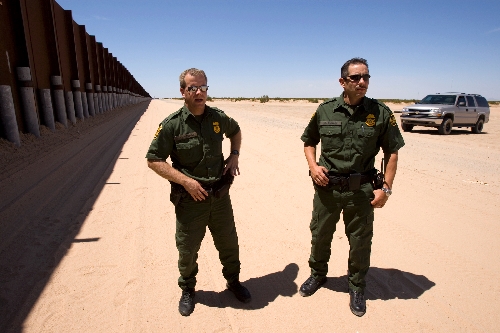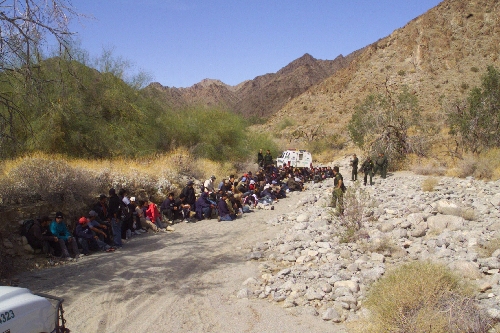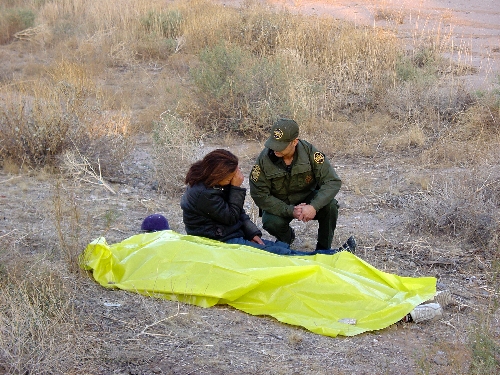Border Patrol finds success in curbing illegal immigration, targets Las Vegas
YUMA, Ariz.
For some Border Patrol agents, boredom has replaced illegal immigration as Public Enemy No. 1. That is a good thing, said Chris Van Wagenen, a supervisory agent, as he steered his SUV past cotton fields near the Colorado River in late August.
"It's been a very hard battle to get where we are," he said. "We've gone from getting killed to having things handled."
In the last several years, the Yuma sector's border with Mexico has transformed from one of the busiest, most dangerous hot spots for illegal crossings to practically sleepy.
The U.S. Border Patrol now considers the sector, which includes 126 miles of U.S.-Mexico border, to be under "operational control," and it is a model for other sectors that line the border.
This unprecedented level of control has allowed Yuma to branch out and focus more of its efforts on areas within its sector but farther from the border, including a city 300 miles away that officials say has become a hub for human and drug smuggling from Mexico.
U.S. Border Patrol agents recently descended upon that city -- Las Vegas -- where they raided several bus stations, arrested 31 suspected illegal immigrants and angered some in the Hispanic community.
A closer look at the Yuma sector's remarkable transformation reveals how and why the agents ended up in Las Vegas and why they probably will be keeping closer watch over the Las Vegas Valley in the future.
Now and then
At just past noon, it's well beyond 100 degrees and humid on the southern outskirts of Yuma, one of America's hottest cities.
Every thousand yards or so, another Border Patrol agent slowly patrols the U.S.-Mexico border in his trademark white truck, scanning the line from behind sunglasses, vigilantly watching nothing happen.
Even as divisive national debates over illegal immigration and how to "secure the border" rage on, those who live on the U.S. side near Yuma have grown accustomed to quieter streets.
Farmers began replanting fields where growing crops had been impossible because they were so decimated by nonstop foot traffic from the south.
Those whose backyards face the border slowly reclaimed them, pinning laundry on once empty clotheslines, setting up picnic tables on previously barren lawns.
And Border Patrol agents who signed up for what they thought would be adrenaline-fueled shifts of busting illegal immigrants must find a way to stay alert and focused while sometimes going days without spotting anyone at all.
It's a sharp contrast to five years ago, when agents encountered daily "banzai runs," dozens of people pouring over the border together, knowing it probably would be impossible for outnumbered agents to capture them all.
On busy days back then, agents might apprehend more than 800 undocumented border-crossers.
Hundreds of vehicles full of illegal immigrants or drugs crossed the Colorado River on makeshift sandbag bridges or through the open desert. They often refused to stop for agents, resulting in chases, accidents and deaths.
Van Wagenen was on duty in August 2006 when a smuggler fled from Yuma Border Patrol agents in a Chevrolet Suburban packed with 20 illegal immigrants.
The van rolled over after the driver, Adan Pineda-Doval, swerved to avoid a spike-strip agents had placed on the road. Ten passengers died in the crash, including a 17-year-old woman who was pregnant.
Some family members of those killed or injured blamed the Border Patrol. But Van Wagenen said the deaths would have been avoided had Pineda-Doval simply stopped when Border Patrol agents instructed him to do so.
"All he saw was dollar signs," he said.
During the sector's busiest years, countless people succeeded in making it into the United States. They included drug and human smugglers, along with families in search of a better life. The latter sometimes became victims of smugglers, who abandoned the weak or sick to die in the desert.
In 2005, Border Patrol agents in the Yuma sector apprehended 138,460 illegal immigrants. In 2009, that number had fallen about 95 percent to 6,951.
Van Wagenen, who decided to become a Border Patrol agent after the 9/11 terrorist attacks, doesn't miss the old days when Yuma's agents were regularly pelted with rocks or fired upon.
"I won't lie to you; it was exciting," Van Wagenen, 38, said. "But it was frustrating, day in and day out, to be fighting a battle you weren't sure you were ever going to win."
Securing the Yuma sector
In mid-2006, President George W. Bush visited Yuma, where he announced the launch of Operation Jump Start.
The program brought hundreds of National Guard troops to the area to help monitor the border. The troops didn't perform law enforcement functions nor arrest illegal immigrants, but their presence and surveillance were instrumental in stemming the tide of illegal crossers.
"When the help finally came, it was amazing," Van Wagenen said.
Over the next couple of years, the troops constructed nearly impenetrable barriers along much of the Yuma sector's border with Mexico, including 68 miles of vehicle and pedestrian fencing across the Sonoran Desert.
All of the sector's 126 miles of border now have some type of man-made or natural barriers.
"Everything that can be fenced is fenced," Van Wagenen said.
The number of Border Patrol agents in Yuma also has almost tripled, from 330 in 2004 to more than 900 today. It's difficult now to go anywhere along the border near Yuma without quickly being met by an agent.
The Bush administration approved a program called Operation Streamline that requires prosecution, instead of simple deportation, of every adult caught illegally crossing the border in the Yuma sector. Would-be border crossers now must weigh more serious consequences that come with the zero-tolerance program when deciding whether it is worth the risk to cross through the Yuma sector.
Most first-time crossers are charged with misdemeanor illegal entry, which carries a maximum sentence of six months. Those who cross a second or subsequent times can be charged with felony illegal re-entry and serve up to two years in prison.
Civil rights groups have criticized Operation Streamline for routing nonviolent undocumented migrants into the federal criminal justice system and into U.S. prisons instead of into civil deportation proceedings.
The groups also say the program diverts scarce resources from more important law enforcement priorities and politicizes prosecutorial decisions.
Whatever the case, the program seems to have succeeded in deterring some from crossing illegally near Yuma.
"Word got south quick," said Kenneth Quillin, a supervisory Border Patrol agent in Yuma. "They aren't crossing in this area anymore."
The recession also had an impact on overall immigration. The flow of immigrants from Mexico to the United States has declined sharply since 2005, according to the Pew Hispanic Center, a Washington think tank.
Residents in towns on either side of the border near Yuma say it was the combination of stepped-up enforcement and fewer U.S. jobs that kept many in the area from crossing illegally.
"Young men used to cross to work in the fields or as day laborers, then send money back to take care of their families," Marco Mesa Morales said in Spanish after sharing breakfast with fellow taxi drivers in San Luis Rio Colorado, Mexico. "Now they can't get across, and maybe couldn't find a job anyway."
Some of those young men have landed lower-paying jobs in local clothing or electronics factories, Mesa Morales said. But overall, "people are suffering."
Just across the border in San Luis, Arizona, six men gather at a park picnic table each morning to chat about the day's news.
The men, who wouldn't give their names, said since construction of new fencing -- triple-layered in some areas -- the town has grown much quieter.
"It's not easy to cross here anymore," one of the men said. "They send everybody to jail."
A new route for smugglers
Interstate 10 between Los Angeles and Phoenix has long been a favorite route for drug and human smugglers forced to resort to land routes because of stepped-up airport security and identification requirements.
But the 375-mile route passes directly through Blythe, Calif., in the Yuma sector, and many smugglers in recent years abandoned the interstate as Border Patrol agents increased their presence there.
"We've got Interstate 10 on lockdown," Quillin said.
Border Patrol intelligence agents noticed that while smuggling had decreased along I-10, drugs and illegal immigrants from Los Angeles still were winding up in Phoenix.
Based on informants and tips, agents determined that smugglers had begun using tourist buses traveling into and out of Las Vegas to transport drugs and people.
"The only other way around that part of the country is to go through Las Vegas," Van Wagenen said.
U.S. Border Patrol officials spent months planning an "intelligence-based operation" and on July 29 sent agents from the Blythe station to conduct raids at several valley bus stations. They arrested 31 people suspected of being illegal immigrants.
Van Wagenen said 12 of those arrested had prior criminal histories, including charges of theft, prostitution and burglary, or immigration-related offenses. Some of the 31 were taken for processing at the Border Patrol station in Blythe. Others were released pending upcoming immigration hearing dates or have already been deported.
The raids began at the same time immigration rights groups had gathered at a local church to celebrate a judge's decision to block the most controversial sections of a new Arizona immigration law, including a section that required officers to check a person's immigration status while enforcing other laws.
Bus station managers said they and their clients, many of whom were American citizens, were harassed because they are Hispanic. Federal agents separated family members, taking some away while others remained behind crying, witnesses said.
Word that federal agents were in town spread quickly through the Hispanic community, stirring fear and rumors of more raids to come. Many people didn't understand what Border Patrol agents were doing so far from the border.
Joel Menchaca, pastor of Amistad Cristiana, held a special prayer vigil at his church in an effort to calm the community. He told congregants any future raids probably would focus on transportation sites, not churches, schools or other neighborhood gathering places.
Things have slowly gotten back to normal in recent weeks, Menchaca said.
"The church was totally full last week," he said. "People are no longer scared to leave the house or go to the store. They saw that more raids didn't immediately happen, so they felt better."
But Emmanuel Corrales, owner of Las Vegas Shuttles, one of the businesses that was targeted by federal agents, said he worries they will soon return.
"They are going to make me and all my clients feel like criminals again," he said. "It's not right."
Corrales, a U.S. citizen, said agents harassed about 40 Hispanic customers at his business during the raid, but ended up arresting only one person from the site.
"I'm not upset about them taking illegal aliens," he said. "I'm upset I have to prove I'm a U.S. citizen in my own office. They targeted us for only one thing, our skin color."
Corrales, who crosses frequently into Mexico and back for work, said he understands inspecting everyone at the border, but "the way it was handled here in Las Vegas, I'm not OK with that."
The Yuma sector includes all of Nevada and parts of Arizona and California. Border Patrol may appear in Las Vegas only rarely, but "we do belong up there," Van Wagenen said.
"People have the misconception that if you get past the Border Patrol you are welcome. There is no statute of limitations on immigration law."
Federal agents have the authority to request documentation proving citizenship and detain someone for a "reasonable amount of time" if they suspect that person is in the United States illegally, Van Wagenen said.
The timing of the raids was coincidental, he said. Whatever might have been going on with Arizona's new immigration law was "none of our business."
"We can't get involved in politics," he said. "We're just doing our job."
Van Wagenen wouldn't say when the Border Patrol will visit Las Vegas again.
"I personally would love to see it happen in the near future, to the extent we have the manpower and resources to do it, we are going to be there."
Contact reporter Lynnette Curtis
at lcurtis@reviewjournal.com.
Yuma Sector Border Patrol






















